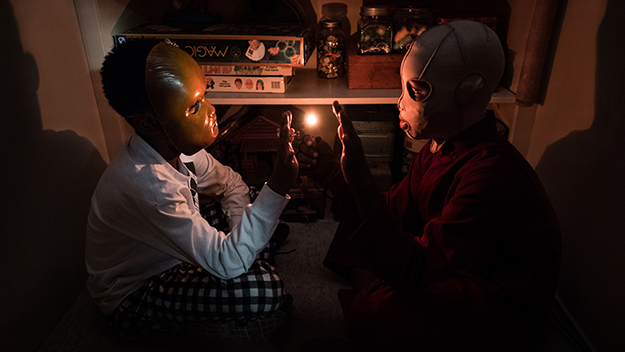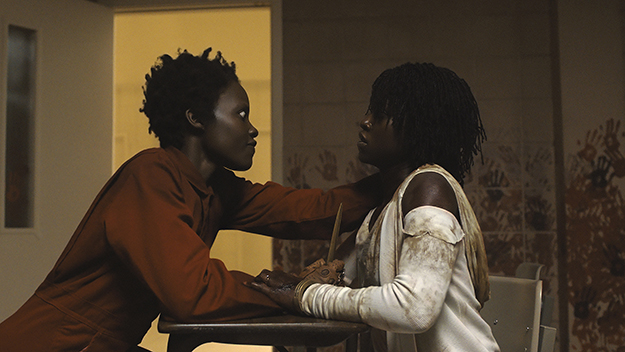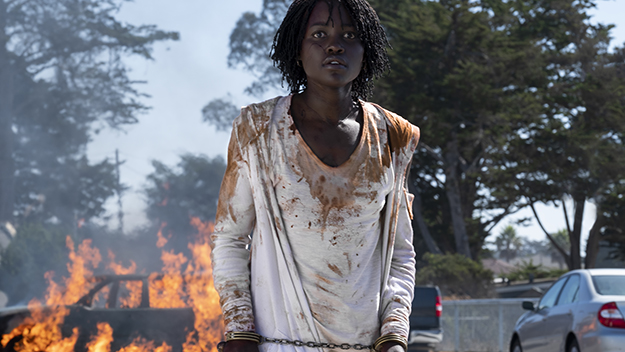Review: Us

Jordan Peele defines his Oscar-winning film, Get Out, as a “social thriller,” and the first of five genre films he plans to make, telling Business Insider, “I’ve been working on these premises about these different social demons, these innately human monsters that are woven into the fabric of how we think and how we interact, and each one of my movies is going to be about a different one of these social demons.” Exploiting more jump scares, action, and violence than Get Out, Us effectively expands on the previous film both generically and thematically, combining the zombie, apocalypse, and home-invasion subgenres to produce a socially conscious horror film.
Like many of the most enduring horror films, Peele taps into the return of the repressed. Us dares us to contemplate what lies beneath the “Find Yourself” hall of mirrors (literally represented by a beachside carnival attraction), both psychologically and spatially leading down a rabbit hole of possible interpretations. In the depths below the earth, Peele reveals a prison-like laboratory/dormitory, rendering a space that might be a national “sunken place”—the hypnotized state that the protagonist of Get Out fears being sent into, in which the black body is paralyzed, expropriated, and stripped of agency while retaining a frightening consciousness of imprisonment. Us signals its intentions, and possibly a key influence, early on. Overhead shots reminiscent of Kubrick’s The Shining introduce the Wilson family before the camera drops down to an image of togetherness: that ubiquitous decal of a stick-figure smiley-face nuclear family on their rear windshield. These figures, hand-in-hand, become a potent symbol in the film, representing much more than just the Wilsons.
We first encounter the family cruising through the mountains, blasting old-school rap (“I Got 5 on It”), heading to Santa Cruz for an annual beach vacation. Howard University grad dad Gabe (Winston Duke)—whose glasses make him look like director Jordan Peele, and who is much more of a teddy bear here than as the intimidating M’Baku in Black Panther—is behind the wheel, surrounded by mother Adelaide (Lupita Nyong’o), irritable teenager Zora (Shahadi Wright Joseph), and slightly weird but sweetly vulnerable son, Jason (Evan Alex). The Wilsons arrive and meet up with friends and boozy neighbors Josh and Kitty Tyler (Tim Heidecker and Elisabeth Moss) and their mean-girl twin teens and, though the Tylers’ new boat opens up a friendly economic rivalry, all signs indicate clear sailing ahead. Adelaide, however, has been haunted by a series of foreboding premonitions, which are soon validated. Later that evening, the power fails, and a family of eerie doppelgängers, clad in red coveralls, suddenly appears at the Wilsons’ vacation house.

Us turns out to be filled with doubles and twins, a gothic perennial of the uncanny that Peele taps into. The double has a long history on screen, with classics indebted to the trope’s disquieting powers including not only The Shining and its twins but Vertigo as well. But mirroring is not the only tool that Peele employs to elicit chills in a movie dotted with allusions to both social and film history. The accumulation of carefully placed details, dialogue clues, and cultural references—a Black Flag T-shirt nods toward rebellion and anarchy, a set of handcuffs not-so-discreetly toward slavery—drives the narrative and provides viewers with pieces to puzzle over long after the lights come up. For horror aficionados, the golf club used as a weapon might bring to mind Michael Haneke’s disturbing Funny Games, and a shot of black gloves may evoke a giallo predator. Scissors, a prominent motif in the film’s advertising campaign, are a tried-and-true emblem of the genre (and another nod to doubling). Despite the allusions, the film is Peele’s own—intricately woven, thoughtfully layered, and terrifyingly fun to watch. God—as evoked in Jeremiah 11:11, quoted in the movie—is in the details.
There is another doubling at work between the genre twins of horror and the musical. Both require a suspension of disbelief and make narrative use of music and choreography. Music and dance are put to dazzling use during the film’s climax, in which Nyong’o performs a balletic Odette/Odile dance of violence and pursuit of self. All of the actors are terrific and are clearly relishing the challenge of articulating nuances of characterization as they transform over the course of the film into the doubles, who in turn stand in for us, the audience. Newcomer Madison Curry as young Adelaide is, in particular, a standout—Peele’s highlighting of girls and women as leaders instead of victims is bracing. Considering the nuances of enacting multiple selves made me wonder: are black actors, already burdened by a DuBoisian double consciousness, more versed in portraying layers of characterizations?

Us features beautiful cinematography by Mike Gioulakis, whose credits include the viral (in all the wrong ways) chiller It Follows, and who photographs black skin in rich and scary chiaroscuro, delineating the “real” characters from their doubles. The editing by Nicholas Monsour (a veteran of Key & Peele as well as the goofy gangsta kitten comedy Keanu) is a tour de force, and all the elements of the production work together to create an atmospheric menace that occupies a breathless two-thirds of the high-intensity 116-minute running time. Fortunately, regular doses of humor prevent the pace from becoming overwhelming.
The beginning of the film cryptically references the bizarre 1986 pre–social media campaign Hands Across America, in which 6.5 million (North) Americans linked hands, from California to New York City, in a branded and symbolic effort to fight poverty and homelessness. The ’80s were a frightening time in many ways, as the long hangover from the ’60s gave way to Reagan’s reactionary politics, the Chernobyl disaster, the Iran-Contra scandal, and the Christian Coalition. (Possibly in response, the era was also a heyday for the slasher flick.) In Us, that not-so-distant past is prologue, and the echoing image of paper dolls, hand in hand, becomes a major motif and a potent symbol of spatial, generational, and national trauma. Ultimately, the return of the repressed which Peele’s film points to lies in the legacies of failed and facile social programs, passed down through the years—the underlying horror haunting both the family in Us, and the U.S.
Ina Diane Archer is an artist and filmmaker and a media conservator at the Smithsonian National Museum of African American History and Culture.







